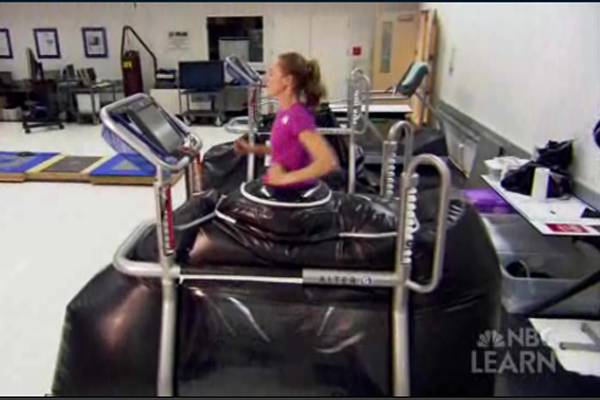How an 'Anti-Gravity Treadmill' Helps Olympic Runners Recover from Injuries

Olympic runners may seem superhuman — able to race around the track without appearing to break a sweat — but they can suffer wear and tear in their joints just like the rest of us.
This was the certainly case for U.S. Olympic runner Jenny Simpson, a medal contender in this week's 1500-meter race, who developed a stress fracture in her right femur prior the London Games. She says the fracture was a direct result of the impact of running.
"There's no doubt it's because of the consistent and constant impact on my legs," Simpson said, in an interview with the National Science Foundation (NSF).
Olympic track stars and recreational runners alike can develop stress fractures in bones, or soft tissue injuries in joints due to the repetitive impact of their feet hitting the ground.
Every time the foot comes down, the ground provides force to stop it. This force passes from the foot, to the knees, up through the hips and even to the back.
Over the years, engineers have come up with a few solutions to the problem of these impacts. Cushioned running shoes and softer track surfaces reduce impact by allowing the foot to stop more slowly.
And now, athletes can help protect their bodies by training on an "anti-gravity treadmill." The treadmill does not actually reduce gravity, but has a pressure chamber that supports some of the body's weight, making the runner feel lighter. [Watch video of the anti-gravity treadmill in action.]
Get the world’s most fascinating discoveries delivered straight to your inbox.
"Running on an antigravity treadmill would relive a good deal of the pressure from the joints because you don't have the same forces coming back through the ground into the lower extremities, and back up to the spine," said Justin Laferrier, a physical therapist at the University of Pittsburg.
Simpson trained on the anti-gravity treadmill while recovering from her stress fracture.
"You feel like you're running on the moon or something. You just feel like you're bounding," Simpson said.
Thanks to this feat of modern engineering, Simpson was able to prepare for the 1500-meter race at the 2011 World Championship, which she won, and head to the Olympics.
MyHealthNewsDaily a sister site to LiveScience. Follow LiveScience on Twitter @livescience. We're also on Facebook & Google+.

Rachael is a Live Science contributor, and was a former channel editor and senior writer for Live Science between 2010 and 2022. She has a master's degree in journalism from New York University's Science, Health and Environmental Reporting Program. She also holds a B.S. in molecular biology and an M.S. in biology from the University of California, San Diego. Her work has appeared in Scienceline, The Washington Post and Scientific American.


